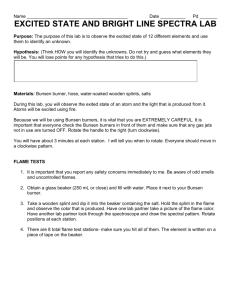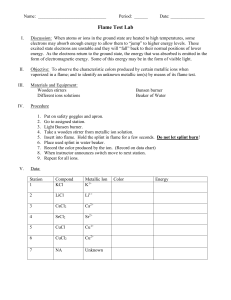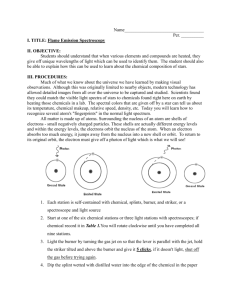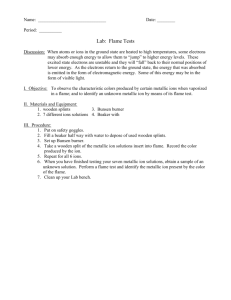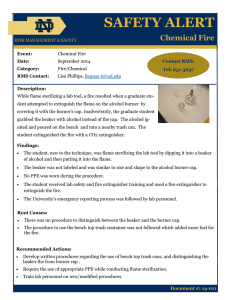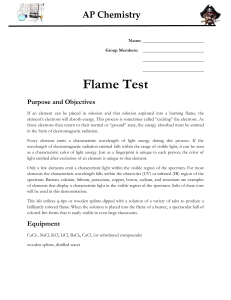Flame Test Lab - newshamchemistry
advertisement
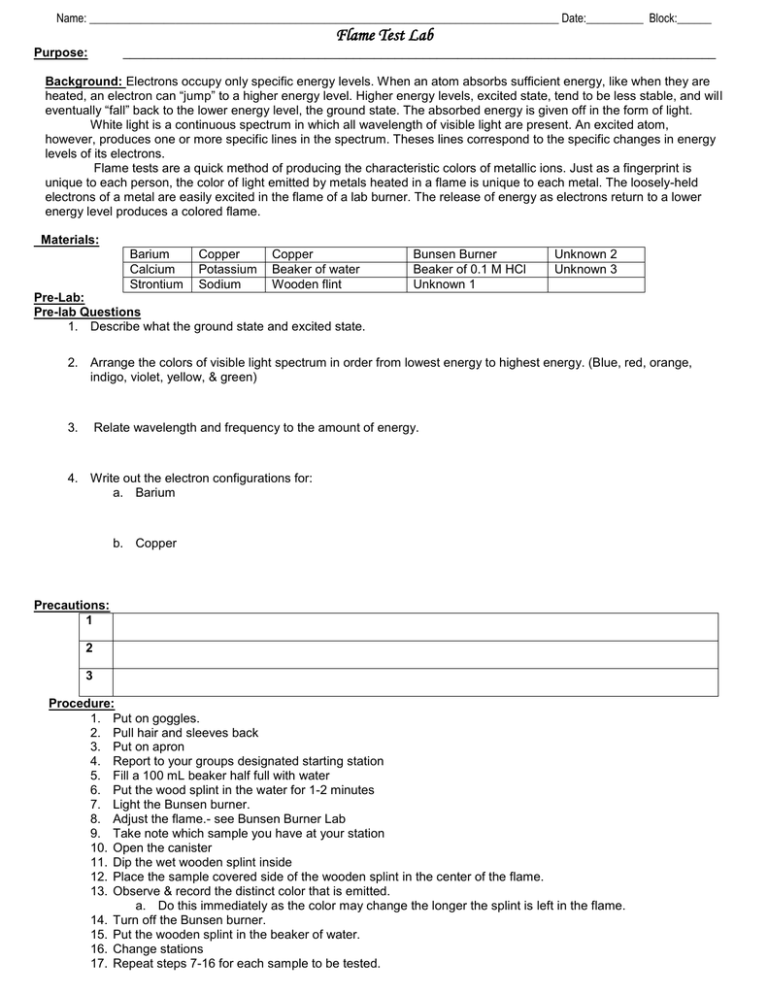
Name: __________________________________________________________________________________ Date:__________ Block:______ Flame Test Lab Purpose: _____________________________________________________________________________________ Background: Electrons occupy only specific energy levels. When an atom absorbs sufficient energy, like when they are heated, an electron can “jump” to a higher energy level. Higher energy levels, excited state, tend to be less stable, and will eventually “fall” back to the lower energy level, the ground state. The absorbed energy is given off in the form of light. White light is a continuous spectrum in which all wavelength of visible light are present. An excited atom, however, produces one or more specific lines in the spectrum. Theses lines correspond to the specific changes in energy levels of its electrons. Flame tests are a quick method of producing the characteristic colors of metallic ions. Just as a fingerprint is unique to each person, the color of light emitted by metals heated in a flame is unique to each metal. The loosely-held electrons of a metal are easily excited in the flame of a lab burner. The release of energy as electrons return to a lower energy level produces a colored flame. Materials: Barium Calcium Strontium Copper Potassium Sodium Copper Beaker of water Wooden flint Bunsen Burner Beaker of 0.1 M HCl Unknown 1 Unknown 2 Unknown 3 Pre-Lab: Pre-lab Questions 1. Describe what the ground state and excited state. 2. Arrange the colors of visible light spectrum in order from lowest energy to highest energy. (Blue, red, orange, indigo, violet, yellow, & green) 3. Relate wavelength and frequency to the amount of energy. 4. Write out the electron configurations for: a. Barium b. Copper Precautions: 1 2 3 Procedure: 1. Put on goggles. 2. Pull hair and sleeves back 3. Put on apron 4. Report to your groups designated starting station 5. Fill a 100 mL beaker half full with water 6. Put the wood splint in the water for 1-2 minutes 7. Light the Bunsen burner. 8. Adjust the flame.- see Bunsen Burner Lab 9. Take note which sample you have at your station 10. Open the canister 11. Dip the wet wooden splint inside 12. Place the sample covered side of the wooden splint in the center of the flame. 13. Observe & record the distinct color that is emitted. a. Do this immediately as the color may change the longer the splint is left in the flame. 14. Turn off the Bunsen burner. 15. Put the wooden splint in the beaker of water. 16. Change stations 17. Repeat steps 7-16 for each sample to be tested. Data Table: Metal Color- be specific Barium Metal Sodium Copper Calcium Potassium Strontium Color/Observations- be specific Color- be specific Identity Unknown 1 Unknown 2 Unknown 3 Conclusion: 1. Which elements are easiest to identify? Discuss what makes them easy? 2. Which elements are most difficult to identify? What makes them difficult? 3. Explain what happens to the electrons as they are being heated. 4. In this lab you observed that the colors of the flames in each sample are different. Why don’t all flames have the same color? Explain. 5. Use last class computer activity, the demo, and this lab to explain: how do you think metals are used in fireworks? 6. How might this method of identifying elements be important in real life? Explain when it would be handy to identify unknown elements. 7. Answer: a. I have a theory that states there’s a small amount of the element platinum in the sun. Using what you know about light emission from atoms, explain how I might prove or disprove this theory. b. Ultimately, what data must be known to confirm this hypothesis?
